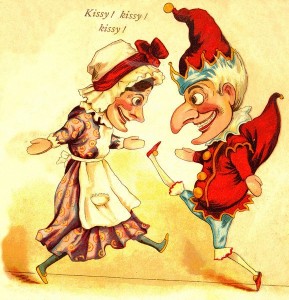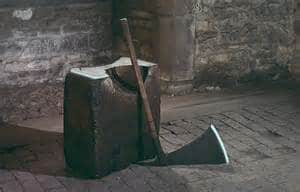 Thank you so much to author and historian Dr Josepha Josephine Wilkinson, author of The Princes in the Tower, Mary Boleyn: The True Story of Henry VIII’s Favourite Mistress and Anne Boleyn: The Young Queen to Be, for sharing this article with us today. And we haven’t made a typo, it really is Henry XXVIII!
Thank you so much to author and historian Dr Josepha Josephine Wilkinson, author of The Princes in the Tower, Mary Boleyn: The True Story of Henry VIII’s Favourite Mistress and Anne Boleyn: The Young Queen to Be, for sharing this article with us today. And we haven’t made a typo, it really is Henry XXVIII!
It was not unknown for puppets to be conscripted into the service of one political cause or another. The Russian version of Mr Punch, Petrushka, is a famous, if tragic example. Another is Mr Punch himself who, by the early twentieth century, had become such a well-known figure that he could be used for such purposes to great effect. Mr Punch was brought in to comment on one of the several political upheavals that threatened to rock the country in the early part of the twentieth century: the emerging suffragette movement.
At the time, Sir Herbert Beerbohm Tree’s production of Shakespeare’s Henry VIII, was playing at Her Majesty’s Theatre. Beerbohn Tree’s production was enormously popular, accomplishing no less than 254 consecutive performances between September 1910 and April 1911. Naturally, such a success came to the attention of the mountebanks and puppet showmen, and a Punch and Judy show opened for business close to the theatre.
In a tall booth, at ten in the morning, the notorious puppet took to the platform, his performance heralded by the sound of the tolling bell. As the curtain rose to reveal the setting within, Mr Punch emerged and began, in his customary way, to insult the audience, before retreating into the confines of his colourful booth.
Then, just as the audience began to wonder what might happen next, Mr Punch reappeared dressed as King Henry XXVIII. ‘It was all very well, he began (and here, we must try to imagine Henry VIII speaking with Punch’s squeaky voice!), ‘for the ordinary run of fatheads to sit through a long-winded play by tiresome William,’ but Mr Punch had rewritten the bard. He had brought him up to date, ‘cut out some superfluous wheezy twaddle and verbiage’ and come up with a new play, ‘hot of the griddle.’
 In Mr Punch’s version, the ‘Merry Monarch’ decided it would be great fun to host a beauty show. His eight wives were shepherded out to cast their vote, if they so wished. Seven of the wives were wise enough to turn down the invitation, but one was more than keen to have her say. This lady was none other than Anne Boleyn, who ‘longed for liberty’. To the dismay of the royal family, who formed an illustrious part of the audience, Henry decided that his seven wise wives, ‘being worthy English wives’ should be allowed to live. As to Anne Boleyn, she must be beheaded, the price of her outspokenness. As with all good Punch and Judy shows, the executioner appears on cue. All geared up to cut off Anne’s head, his axe slipped and he struck Henry in the face instead, taking his off head in a single stroke.
In Mr Punch’s version, the ‘Merry Monarch’ decided it would be great fun to host a beauty show. His eight wives were shepherded out to cast their vote, if they so wished. Seven of the wives were wise enough to turn down the invitation, but one was more than keen to have her say. This lady was none other than Anne Boleyn, who ‘longed for liberty’. To the dismay of the royal family, who formed an illustrious part of the audience, Henry decided that his seven wise wives, ‘being worthy English wives’ should be allowed to live. As to Anne Boleyn, she must be beheaded, the price of her outspokenness. As with all good Punch and Judy shows, the executioner appears on cue. All geared up to cut off Anne’s head, his axe slipped and he struck Henry in the face instead, taking his off head in a single stroke.
The play retains some of the elements that were characteristic of the ancient performances. There is the bawdy humour, the sense of irreverence to all and sundry, it plays upon factors meaningful to its time and it has a strong moral tone. In this case, it tacitly, albeit unintentionally, supports the suffragette movement by finishing off one who would suppress their cause.
Naturally, being a variation of Punch and Judy, it takes astonishing liberties with historical fact. Henry is described as the ‘Merry Monarch’, an epithet that was actually applied to Charles II. Henry was ‘Bluff King Hal’.1 Henry has eight wives in this play as opposed to the six he actually had; but perhaps, like Mr Punch, Henry’s mistresses were also given starring roles. Although the Tudor court was known for its pageants and spectacles, as were many European courts at the time, beauty contests were unknown. Moreover, the idea that a woman, even a queen, would be called upon to cast a vote was definitely unheard of. The seven wives who abstained were considered ‘wise’, as indeed they were; it would be foolhardy for a woman to express an opinion, for what would happen should she disagree with the king? The seven, their silence and submission being seen as virtuous, fulfilled their proper roles as wives. This allowed them to live – even Katherine Howard survives this story. Anne Boleyn, however, was different. She is every bit as strong-willed and independent as her historical counterpart, whose character of Perseverance continues to echo through the centuries since she first danced the part. She is depicted as the prototypical feminist fighting for the ultimate feminist cause, the Suffragette Movement. Her ‘outspokenness’, as it is called here, earned her the wrath of her husband, who decided she must be beheaded. No elegant and efficient French swordsman for Mr Punch’s Anne, she must make do with the axe. However, the execution is as incompetent as ever he is. This reincarnation of Jack Ketch makes to behead Anne but accidentally kills Henry instead. Here is poetic justice. The historical Anne may have fallen victim to a cruel and tyrannical king, but, thanks to Mr Punch, she at last got her revenge.

Dr Wilkinson has written guest articles for us before, see Richard III’s Burial Place and An Interview with Josephine Wilkinson.
Note
- Bluff King Hal was full of beans
He married half a dozen queens
For three called Kate they cried the banns
And one called Jane, and a couple of Annes.